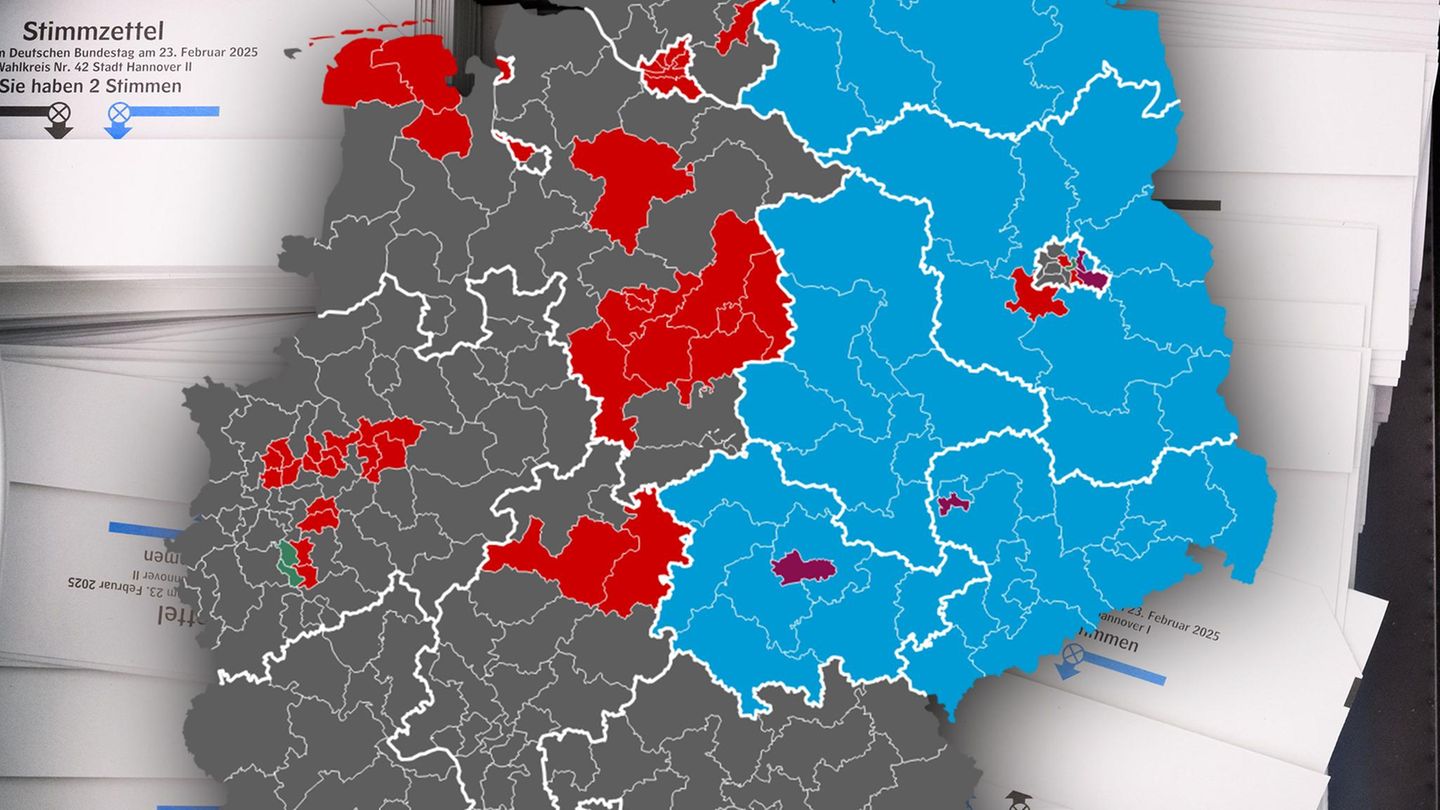Bundestag election 2025
This is what the forecast for all constituencies looks like
Copy the current link
Add to the memorial list
The countdown is running: votes on Sunday. What do the forecasts look like shortly before the Bundestag election? It shows an estimate for all constituencies in Germany.
Germany is facing the choice: On Sunday, the people voted on the political future of the Federal Republic. A few days before the Bundestag election, the YouGov opinion research institute provides an estimate for the outcome including the first votes in all 299 constituencies (more about the methodology at the end of the article). If the results would occur on Sunday as estimated in the YouGov election model, one would look like a map of Germany colored according to the party colors of the electoral winners as in the graphic below: mostly black in the west, fairly blue in the east.
In our Live ticker for the Bundestag election 2025 Find current news on the early new elections every day.
The Union parties CDU/CSU would get 197 constituencies in the model51 more than in the 2021 election. The SPD, on the other hand, would only come to 44 constituencies76 less than four years ago. The Greens would have seven direct mandates And thus lost nine compared to 2021. With 47 constituencies 33, the AfD would win more than in the last Bundestag election.
The left would also have reason to be happy: the party could win four constituencies directlyone more than 2021: Erfurt/Weimar/Weimarer Land II, Berlin-Treptow-Köpenick, Leipzig II, and Berlin-Lichtenberg. The first two are part of the so -called “Mission Silberlocke” by Bodo Ramelow, Gregor Gysi and Dietmar Bartsch. According to the estimate, Bartsch would only land in second place in his constituency Rostock II in his constituency Rostock – Landkreis Rostock II. Sören Pellmann would defend his direct mandate in Leipzig, and Co-party leader Ines Schwerdtner also win her constituency in Lichtenberg. According to estimate, there is a head-to-head race in 72 constituencies, and despite sometimes a thin lead, they are considered undecided.
The Bundestag election 2025 at the Stern
The star informs you comprehensively about all current developments in the Bundestag election on February 23, 2025. All content is bundled here on our special page, including:
Note on use: Drive the mouse with the mouse in the graphic below or click on it to get a detailed overview of the estimates. You can zoom into the map and move the neckline.
At this point, our editorial team has integrated content from Datawrapper GmbH.
Due to their data protection settings, this content was not invited to protect their privacy.
Second votes: FDP and BSW would be outside, Groko probably the only realistic option
With a view to the second vote results Again, according to the estimate, both FDP and BSW would fail due to the five percent hurdle and would not move into the Bundestag. The left, on the other hand, would be represented in the parliament with an estimated 7.5 percent second vote. The Südschleswig voters' association (SSW) is still represented in the model with a seat.
Among the possible government allies would be a grand coalition (Groko) from the Union and SPD as well as a black and red-green triangle in the scenario. In contrast, black-green and red-red-green would have no majority. Black and blue would also have enough seats, but CDU candidate for chancellor Friedrich Merz categorically excluded a coalition with the AfD.
At this point, our editorial team has integrated content from Datawrapper GmbH.
Due to their data protection settings, this content was not invited to protect their privacy.
Incidentally, about all current developments regarding the Bundestag election If the star live blog keeps it up to date, There is also The special star side to choose.
YouGov uses a so-called multi-level regression model with postaltratification (MRP) for his estimates. An MRP model should also provide reliable estimates for the total population from survey data even with possibly not perfectly representative samples. In a statistical model, the relationship between a variety of characteristics of potential voters (e.g. age, gender, region) and their political preferences is estimated. The model is then combined and weighted with real population data in order to obtain a more precise estimate. Yougov carries out 15,000 interviews per week for his election model, at least 35 per constituency and also uses data from the federal election manager and further structural data for modeling the voting intention at the constituency level.
The strengths and weaknesses of the model: By combining the statistical model with population data, more precisely estimates should also be achieved with smaller samples and possibly distorted surveys. However, distortions cannot always be completely balanced. If a group is completely missing in a constituency, an MRP model cannot correct it. The estimates can also distort outdated or inaccurate population data.
Source: Stern
I have been working in the news industry for over 6 years, first as a reporter and now as an editor. I have covered politics extensively, and my work has appeared in major newspapers and online news outlets around the world. In addition to my writing, I also contribute regularly to 24 Hours World.




